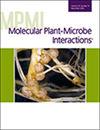求助PDF
{"title":"鞘氨醇假单胞菌(Pseudomonas syringae)中的重氮二酸酯信号可上调毒力因子并促进植物存活。","authors":"Qiang Guo, Caitlin N Vitro, Drake M Crawford, Bo Li","doi":"10.1094/MPMI-06-24-0069-R","DOIUrl":null,"url":null,"abstract":"<p><p><i>Pseudomonas syringae</i> infects a wide variety of crops. The <i>mangotoxin-generating operon</i> (<i>mgo</i>) is conserved across many <i>P. syringae</i> strains and is responsible for producing an extracellular chemical signal, leudiazen. Disruption of the <i>mgoA</i> gene in <i>P. syringae</i> pv. <i>syringae</i> (<i>Pss</i>) UMAF0158 alleviated tomato chlorosis caused by this bacterium. We showed that deletion of the entire <i>mgo</i> reduced <i>Pss</i> UMAF0158 population in tomato leaflets. Leudiazen restored the signaling activity of the deletion mutant at a concentration as low as 10 nM. Both the diazeniumdiolate and isobutyl groups of leudiazen are critical for this potent signaling activity. Transcriptional analysis showed that <i>mgo</i> and leudiazen induce the expression of <i>mangotoxin biosynthetic operon</i> as well as an uncharacterized gene cluster, RS17235-RS17245. We found that this cluster enhances the survival of <i>Pss</i> UMAF0158 in planta and is widely distributed in <i>P. syringae</i> strains. Our results demonstrate that <i>mgo</i> plays prominent roles in the virulence and growth of <i>P. syringae</i>. The <i>mgo</i> and <i>mgo</i>-like signaling systems in different bacteria likely regulate diverse microbe-host interactions. [Formula: see text] Copyright © 2024 The Author(s). This is an open access article distributed under the CC BY 4.0 International license.</p>","PeriodicalId":19009,"journal":{"name":"Molecular Plant-microbe Interactions","volume":" ","pages":"776-783"},"PeriodicalIF":3.4000,"publicationDate":"2024-11-01","publicationTypes":"Journal Article","fieldsOfStudy":null,"isOpenAccess":false,"openAccessPdf":"","citationCount":"0","resultStr":"{\"title\":\"A Diazeniumdiolate Signal in <i>Pseudomonas syringae</i> Upregulates Virulence Factors and Promotes Survival in Plants.\",\"authors\":\"Qiang Guo, Caitlin N Vitro, Drake M Crawford, Bo Li\",\"doi\":\"10.1094/MPMI-06-24-0069-R\",\"DOIUrl\":null,\"url\":null,\"abstract\":\"<p><p><i>Pseudomonas syringae</i> infects a wide variety of crops. The <i>mangotoxin-generating operon</i> (<i>mgo</i>) is conserved across many <i>P. syringae</i> strains and is responsible for producing an extracellular chemical signal, leudiazen. Disruption of the <i>mgoA</i> gene in <i>P. syringae</i> pv. <i>syringae</i> (<i>Pss</i>) UMAF0158 alleviated tomato chlorosis caused by this bacterium. We showed that deletion of the entire <i>mgo</i> reduced <i>Pss</i> UMAF0158 population in tomato leaflets. Leudiazen restored the signaling activity of the deletion mutant at a concentration as low as 10 nM. Both the diazeniumdiolate and isobutyl groups of leudiazen are critical for this potent signaling activity. Transcriptional analysis showed that <i>mgo</i> and leudiazen induce the expression of <i>mangotoxin biosynthetic operon</i> as well as an uncharacterized gene cluster, RS17235-RS17245. We found that this cluster enhances the survival of <i>Pss</i> UMAF0158 in planta and is widely distributed in <i>P. syringae</i> strains. Our results demonstrate that <i>mgo</i> plays prominent roles in the virulence and growth of <i>P. syringae</i>. The <i>mgo</i> and <i>mgo</i>-like signaling systems in different bacteria likely regulate diverse microbe-host interactions. [Formula: see text] Copyright © 2024 The Author(s). This is an open access article distributed under the CC BY 4.0 International license.</p>\",\"PeriodicalId\":19009,\"journal\":{\"name\":\"Molecular Plant-microbe Interactions\",\"volume\":\" \",\"pages\":\"776-783\"},\"PeriodicalIF\":3.4000,\"publicationDate\":\"2024-11-01\",\"publicationTypes\":\"Journal Article\",\"fieldsOfStudy\":null,\"isOpenAccess\":false,\"openAccessPdf\":\"\",\"citationCount\":\"0\",\"resultStr\":null,\"platform\":\"Semanticscholar\",\"paperid\":null,\"PeriodicalName\":\"Molecular Plant-microbe Interactions\",\"FirstCategoryId\":\"99\",\"ListUrlMain\":\"https://doi.org/10.1094/MPMI-06-24-0069-R\",\"RegionNum\":3,\"RegionCategory\":\"生物学\",\"ArticlePicture\":[],\"TitleCN\":null,\"AbstractTextCN\":null,\"PMCID\":null,\"EPubDate\":\"2024/11/27 0:00:00\",\"PubModel\":\"Epub\",\"JCR\":\"Q2\",\"JCRName\":\"BIOCHEMISTRY & MOLECULAR BIOLOGY\",\"Score\":null,\"Total\":0}","platform":"Semanticscholar","paperid":null,"PeriodicalName":"Molecular Plant-microbe Interactions","FirstCategoryId":"99","ListUrlMain":"https://doi.org/10.1094/MPMI-06-24-0069-R","RegionNum":3,"RegionCategory":"生物学","ArticlePicture":[],"TitleCN":null,"AbstractTextCN":null,"PMCID":null,"EPubDate":"2024/11/27 0:00:00","PubModel":"Epub","JCR":"Q2","JCRName":"BIOCHEMISTRY & MOLECULAR BIOLOGY","Score":null,"Total":0}
引用次数: 0
引用
批量引用

 求助内容:
求助内容: 应助结果提醒方式:
应助结果提醒方式:


